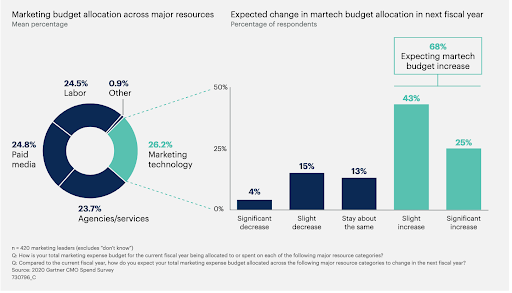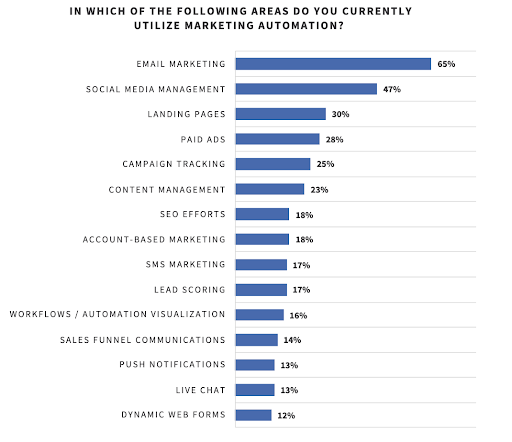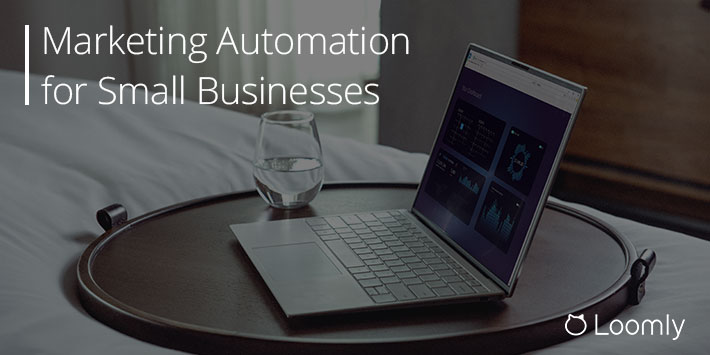Marketing Automation: Getting Started as a Small Business
Is your marketing team as efficient and effective as it could possibly be?
If they don’t use marketing automation tools, they most probably aren’t.
The average marketer spends a third of their time — a whopping two working days a week — sending emails, sorting data, and doing other repetitive, laborious, low-value tasks. Marketing automation can take these off your team’s to-do list, freeing them up to focus on helping your business grow.
Here’s a deep dive into marketing automation: what it is, why you should be using it in your small business, plus our top tips to help you make a success of it.

Manage all your social media accounts in one place.
Craft, schedule, & auto-post content to all your social channels, then track analytics and manage interactions from a single, easy-to-use dashboard.
What is Marketing Automation?
Marketing automation is the process of using software to carry out repetitive marketing tasks.
To automate a task, you give your chosen marketing automation tool a set of instructions called a workflow. Once you set up the workflow, the tool can perform the task on an ongoing basis, without any further input from you.
Why use Marketing Automation Tools?
Marketing automation has four compelling benefits for small businesses:
1. It saves time
Brian Downard and Ehsan Jahandarpour reckon automating social media management can save marketers in excess of six hours a week. Similarly, automating client appointments puts a stop to endless email tennis and slashes scheduling time by 80%.
But cutting the amount of admin your marketing team has to deal with on a day-to-day basis only scratches the surface of what marketing automation can do.
From helping you come up with content ideas to optimizing your posts, managing campaigns, and evaluating performance, a good marketing automation tool can help you work faster, be more relevant to your audience, and achieve better results.
2. It allows you to use your resources more efficiently
Marketing automation enables you to do more with less.
Once you’ve set up an automated workflow, tasks that are currently somebody’s full-time job can take care of themselves with minimal supervision. So, instead of spending the day evaluating leads or manually sending out hundreds of outreach emails, your team can focus on more important and — let’s face it — satisfying work like strategy and creative.
Better still, you can streamline internal workflows and procedures across your business. This is more efficient for everyone and makes it easier for different teams — marketing and sales, for instance — to work together hand-in-glove.
3. It helps you build stronger relationships with prospects … and customers
Every marketing team wants better-qualified leads and more engaged, loyal customers. But those who use marketing automation are more likely to achieve these goals, for two reasons.
Firstly, because marketing automation tools excel at collecting and organizing data from several different sources and bringing it together in one place, you’ll have a clearer, more accurate, and complete picture of your audience.
Who are they? What are their pain points? And where are they in the buyer’s journey?
Knowing the answers to these questions means you can segment your audience and tailor your marketing efforts so they’re more timely, more relevant, and have a greater chance of being effective.
Secondly, and more significantly, by automating communications such as welcome emails, follow-ups, upsells, and exclusive offers for repeat customers, you can make sure you never miss a trick — no matter how busy you are with other tasks.
4. It levels the playing field
According to Gartner, large organizations spend around 26.2% of their annual marketing budgets on marketing automation. And 68% consider it so essential to their success that they expect their already hefty budgets to increase in the coming years.

Source: Gartner Annual CMO Spend Survey 2020
But if marketing automation is critical to the heavy hitters, the case for it is even more compelling if you’re a small business.
Marketing automation makes it possible to reach a wider audience, nurture leads, personalize your message, and get your hands on key customer data even if you don’t have the big bucks or a 100-strong marketing team.
This means it’s easier for your business to compete, even with the Goliaths of your industry.
Getting started with marketing automation tools: 5 best practices to set yourself up for success
With hundreds of marketing automation tools on the market — the industry is expected to be worth $10.4 billion by 2025 — the risk of choice paralysis is all too real.
So how do you pick the right marketing automation tool for your business?
And how do you integrate it into your day-to-day activities with minimal disruption and make sure you get the most out of it?
Here are our five top tips to help you put your best foot forward.
1. Define success
Before you even think of looking at marketing automation tools, you should set out what success would look like.
Which processes do you want to automate? And what are you hoping to achieve by doing so?
The most commonly automated marketing tasks are email marketing and social media management. But you can use marketing automation tools for a very broad range of tasks, including:
- Data entry. For example, a marketing automation tool can automatically transfer visitor data to your customer relationship management software after they complete a form on your landing page
- Scoring leads, so your sales team can focus on those that are most valuable and likely to buy from you
- Tracking campaign metrics
- Customer-facing tasks like troubleshooting and handling complaints
With this in mind, it’s helpful to start by identifying which repetitive processes your team is struggling with, as well as any gaps in your current workflow.
What’s taking up most of your time?
And how could you improve these processes to make them more efficient and effective?

Source: Ascent2, The State of Marketing Automation 2021
2. What are your goals?
Once you’ve come up with a list of the processes you’d like to automate, it’s time to set out your goals.
It doesn’t matter if you use SMART, WOOP, or some other cleverly-acronymed goal-setting technique. That said, as a minimum, your goals should be:
- In line with your business objectives
- Measurable
- Realistic
You should also set out the key metrics you’ll use to track progress and evaluate whether you’ve reached your goals. This will make it easy to understand whether you’re getting your money’s worth from your investment. And, if not, why not.
3. Pick your tool
Once you know what you want to automate, why, and how you’ll measure success, it’s time to choose your software.
It’s tempting to Google ‘best marketing automation tool for [insert whatever you’ll be using it for here]’ and pick the most popular tool. But, at the risk of stating the obvious, just because a tool is popular, it isn’t necessarily right for you.
So how do you choose?
Here are four things to consider:
- User interface
How easy is the software to use? Is the navigation clear and intuitive? Or do you have to switch between several different screens and jump through multiple hoops just to do something basic?
Even the most intuitive software ever made will have a learning curve. That said, the clunkier the interface, the harder it’ll be for your team to get to grips with the software and the longer it’ll take for you to see a return on your investment.
Most good marketing automation tools have free trials. It’s worth signing up and testing any software you’re considering before you commit.
- Features
Can the tool do what you need it to do? And is it compatible with other technologies you use in your business?
The vast majority of software these days uses APIs to seamlessly integrate and communicate with other software. But it’s worth checking nonetheless.
It’s also worth thinking about the future.
Does the software have additional features and functionality you could use should you decide to implement more marketing automation in the future? It’s easier — and far less disruptive — to stick with software you already know and use, than to switch to something new.
- Ease of setup and onboarding
Once you buy a tool, chances are you’ll need help setting it up. And while most vendors offer some form of support, some do it better than others.
Things you should consider include:
-
- Is setup included, or will the vendor charge an additional fee?
- How does onboarding happen? Ever since the Covid-19 pandemic started, most customer service interactions, including software onboarding, happen remotely. But it’s worth checking if they can offer in-person assistance should onboarding prove tricky
- What are their learning materials like? And do they offer user training, should you need it?
- Customer support
As a minimum, a good marketing automation tool will provide you with regular updates and a service level agreement that guarantees the software will run smoothly, reliably, and securely.
You should also check when — and how — you can get in touch with customer support. If something can go wrong, chances are it will, especially if you’ve just started using a new and unfamiliar system. Make sure your vendor won’t leave you in the lurch.
Crucially, you should involve the people who’ll be using the software in your decision-making process. And you should do this as soon as possible.
84% of software implementation projects fail because end-users don’t adopt the software — either because it’s too complicated to use or doesn’t meet their needs.
Getting your team on board early and listening to what they have to say will help you make sure you pick software that makes their lives easier, not more difficult.
4. Start small
As tempting as it might be to go to town and automate everything, the more sensible course of action is to start small and scale slowly. This will allow you to keep any teething problems manageable, instead of breaking everything.
Let’s say you want to automate your social media management.
A good way to start is to use your new marketing automation tool to schedule your content, so it’s pushed to all your social feeds automatically.
Once your team has the scheduling process down and it’s working smoothly, you can look at automating other social media management processes.
For example, you could start adding RSS feeds, trends, and other content to your workflow so you can use it as inspiration for your content creation process.
And, once you’re comfortable with that, you can look at using your tool to automate other processes. Content creation and approvals, for instance. Or organizing your content library in one place.
5. Measure. Optimize. Then optimize some more.
As Bill Gates once put it:
“The first rule of any technology used in a business is that automation applied to an efficient operation will magnify the efficiency. The second is that automation applied to an inefficient operation will magnify the inefficiency.”
This is why keeping tabs on your progress is crucial.
How have your processes improved since you’ve started using marketing automation?
And, more importantly, what isn’t working?
Looking at the data and making adjustments on a regular basis will help you stay on track and keep bettering your results.
Marketing automation for small businesses in a nutshell
Short of inventing time travel, there are only so many hours in a day.
Luckily, you don’t have to study flux capacitors — or find an eccentric scientist to befriend — to help your marketing team get more done. With the right marketing automation tool, you can save time, work more efficiently, and give your competitors a run for their money.
Just remember to choose your vendor wisely, start small, and keep optimizing. You’ll be well on your way to marketing automation success.



